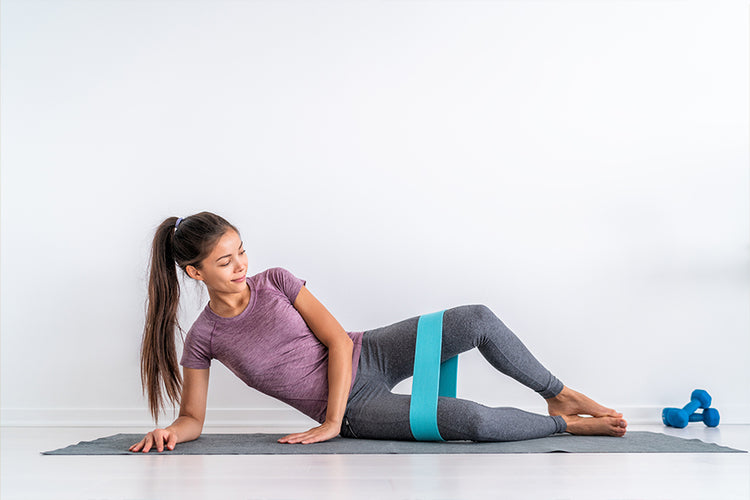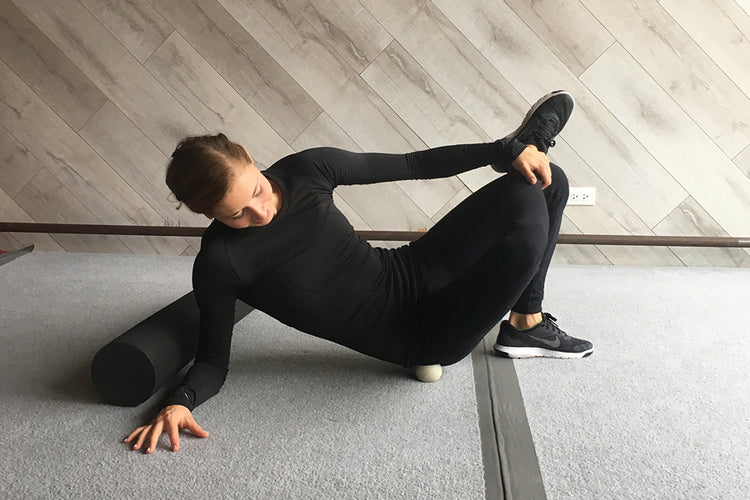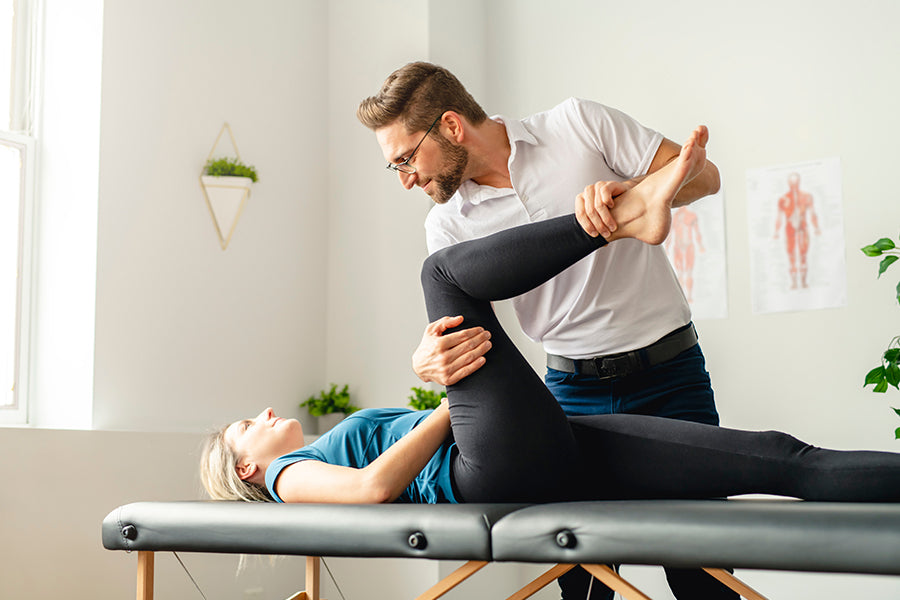Are you tired of feeling like your hip is on strike and permanently stuck in one spot? Well, you're not alone! Many of us struggle with limited mobility in this crucial joint. But let's not let our hips hold us back any longer. It's time to get flexible, and feel free!
Don't give up on your dream body just yet. Sure, your hips might not rotate internally like a pro dancer's, but you can get there with some hard work and dedication.
Get ready to loosen up those hips with our top 6 go-to exercises and stretches for internal hip rotation. Don't let tight hips keep you in a rut. Join me on this journey to freedom of movement, and let's bust a move together!
Related Article: Hanging Leg Raises: Proper Form, Variations, and Common Mistakes
What Is Hip Internal Rotation?

Unlocking the power of hip internal rotation may sound intimidating, but trust us, it's worth paying attention to. It's the key to perfect posture and easing strain on your body.
Plus, once you've mastered it, you'll have a broader range of motion to tackle even the trickiest yoga poses. Don't let your hips hold you back-embrace the rotation and take your practice to the next level!
According to the experts, adding some hip internal rotation exercises to your daily routine is the way to go. So what are you waiting for? Leap and discover the perks of this trendy movement. Who knows, you might surprise yourself!
Want to learn a simple yet effective move? Stand up and twist your thigh inward till your foot turns and your toes point inward - it's that easy!
Related Article: Hip Flexor Exercises to Improve Strength and Flexibility
Why Is Hip Internal Rotation Important?
Internal rotation helps prevent back pain. If you have reduced internal range of motion in your hip, you will compensate in your lumbar spine. It also improves your balance and helps you become more stable.
Take control of the floor - master your hip internal rotation today. That's why it's essential to maintain good hip mobility so you can move freely and stay active without constant aches and pains.
Strong hip internal rotators mean more robust and more stable joints for more excellent performance and less risk of injury - sounds great, right? Make sure you're investing in hip internal rotation regularly; it is essential to maintaining pain-free movement.
Muscles of Hip Complex

Do you want to know what muscles make up your hip complex? We've got the 411. Brace yourself for this fun fact: a whopping 21 mighty muscles come into play. They're all essential for proper hip movement, balance, and action. Talk about teamwork! Some of the real MVPs in this muscle squad include.
Gluteal Muscles
This muscle include the gluteus maximus, gluteus medius, gluteus minimus, and tensor fasciae latae. The gluteus Maximus is the buttocks' most potent and most significant muscle. It is the most vital external rotator muscle of the hip.
Iliopsoas Muscle
The Psoas major and the iliacus are two individual muscles that form the iliopsoas muscle. These muscles are separate in the abdomen but join each other in the thigh.
The psoas is in the lower lumbar and passes through the pelvis to the thigh bone or femur. This muscle assists with the external rotation of the hip. Psoas minor is its sister muscle, even though it is only present in 60-65% of people.
Lateral Rotator Muscles
It includes the following:
- Obturator internus and obturator externus
- Piriformis
- Quadratus femoris
- Gemellus inferior and gemellus superior
Adductor Muscles
The Adductor group is made of the following muscles:
- Adductor brevis
- Adductor longus
- Adductor magnus
- Pectineus
- Gracilis
6 Best Exercises for Internal Hip Rotation
Before we get moving and shaking with our internal hip rotations, let's give a quick shoutout to our equipment squad. Resistance Bands are the first and foremost thing that can help you in this journey with most of your exercises.
DMoose has introduced its Resistance Loop Band with its exceptional qualities. It diversifies your workout with multiple resistance levels and creates the perfect well-toned glutes for all fitness levels.
So, use this band to stretch your tightened internal rotator hip muscles and enjoy a fully functional hip, and get ready to work on those sneaky hip muscles hidden deep within your legs.
See what we consider the best internal hip rotation exercises. Let's get those hips stretching!
1. Seated Hip Internal Rotation
They are one of the best-kept secrets in strengthening and stabilizing the hips, resulting in greater mobility and strength. Incorporating this simple exercise into your regular fitness routine is easy, and the benefits are endless.
You'll help increase balance and flexibility and reduce pain or discomfort. Seated Hip Internal Rotation makes for a powerful addition to your fitness regimen.
To Do It:
- Begin by sitting on the edge of a sturdy chair or bench. Keep your back straight and feet flat on the floor, hip-width apart.
- Bend your knees to a 90-degree angle, aligning your knees directly above your ankles.
- Keeping your feet stationary and in contact with the ground, slowly rotate your right knee outward, moving it away from your left knee. The movement should originate from the hip, not the knee.
- Hold this position for a few seconds, feeling the stretch in your hip. Then, slowly return your knee to the starting position.
- Repeat the same movement on the left side.
2. Squatting Internal Rotations
Isolating the lower body muscles to perform this exercise means maximizing your strength and stability in your hips and legs. Squatting internal rotations help build more strength and increase your range of motion and balance while ensuring you stay in peak condition for the next training session.
To Do It:
- Start with a deep squat with your hands gripped in front of you.
- Use your left leg to push yourself slightly upwards towards the left side.
- Then, as your right leg falls towards the earth, your hip socket should twist your right thigh inward. Pause and then resume your squat.
- Using your right leg, raise yourself up and to the right. Let your left leg fall towards the ground to form a left hip internal rotation. Pause and repeat the movement on the opposite side.
- Repeat and do 5 to 10 times.
3. 90-90 Foot Lift

The 90-90 foot lift is like a miracle exercise you have to try. Perfectly balancing a hard workout and relaxing stretch, this exercise targets your lower body's three major muscle groups - quads, hamstrings, and glutes - while also activating your core. It's like a mini-workout party in your gym.
And with every liftoff position, you can feel the tension and strength buildup in those internal rotators. Get ready to feel the burn.
To Do It:
- Start by sitting on the mat with your feet flat. You can choose a DMoose Yoga Mat, an all-purpose, thick, anti-slip, and exceptionally durable exercise mat.
- Allow both knees to drop down and to the left so that the inner of your right leg is on the ground and the outside of your left leg is. Your legs should be bent at the knee at 90 degrees.
- Then, try to leave your right foot while keeping your hips and upper body balanced. Lift your right foot and then release.
- Perform 20-30 reps and repeat on the left side.
Related Article: What Are Bad Chest Genetics & How to Fix Them?
4. Seated Banded Internal Rotation
A seated banded internal rotation can significantly improve your ability to build a more dynamic range in your hip. By doing this, you will improve your passive range of motion too. Having more range means less room for injury. It helps build strength, control, and mobility within the body's core.
To Do It:
- Start seated with a resistance band around your ankle.
- Be sure the band is attached to a stable object on the opposite side of your working leg.
- Keeping your knee in line with your hip, internally rotate your hip, swinging your tibia and foot outwards, pulling against the band's tension.
- Slowly control it back to the starting position.
- Do this for 12-15 reps before switching sides.
5. Side Lying Banded Internal Rotation

Side-lying banded internal rotation is a unique form of exercise that provides a deep level of physical and mental engagement. It involves using a short band around your feet.
To Do It:
- Begin by lying on your side on a mat or comfortable surface, with your lower arm supporting your head.
- Attach a resistance band and stack your hips and knees, bending them to a 90-degree angle. Keep your feet in contact with each other throughout the exercise.
- Keeping your feet together, slowly lift your upper knee by rotating at the hip. Your knee should lift while your feet remain in contact with each other.
- Hold the top position for a second, feeling the tension in your hip. Then, slowly return your knee to the starting position, maintaining control over the movement.
- Continue the movement for the desired number of repetitions.
6. Lacrosse Ball on the Hip Internal Rotators

Myofascial release can be another way to unlock more range in your internal rotators. All you need is a lacrosse or tennis ball.
To Do It:
- Lie down and raise your right hip off the ground and then put the ball under the outer side of your hip.
- Massage your right tense fasciae lata muscle with light movements. Try moving your body from side to side or up and down over the ball while tucking and untucking your pelvis.
- Train the gluteus medius and minimus muscles by rolling over onto your back so the ball is below the upper part of your buttocks near your right hip.
- Then try moving from side to side and up and down to release the tension.
- Please switch to the left side and do it for a few minutes to work out the hip's internal rotator muscles.
Related Article: 25 Most Effective Stretches to Do Before Exercising
FAQs
1. How can I treat hip internal rotation pain?
Combining corrective exercises, stretching, and sometimes rest gives you the best chance to move towards feeling better. It's important to note that before any treatment plan is made, you should discuss it with your doctor or physical therapist so they can assess your individual needs.
2. What causes hip internal rotation deficiency?
Things such as overly tight tissue, anatomical variations, and even improper load management during athletics or physical activity can lead to hip internal rotation.
3. Why is hip internal rotation important?
Promoting proper posture and encouraging muscular balance throughout the femur, hip, and lower extremities is essential. With a decreased hip internal rotation, compensations can occur at other joints or the low back. It can lead to chronic pain or joint dysfunction.
4. What are the causes of reduced hip internal rotation?
Sitting for extended periods (with poor posture) can decrease our ability to move through full motion, leading to further restriction as our bodies adapt to that lack of movement. Specific injuries and diseases, such as osteoarthritis and avascular necrosis, also significantly limit our practical range of internal hip rotation.
The Bottom Line
In conclusion, hip internal rotation is an often-overlooked component of hip mobility and overall physical health. Regularly incorporating these six effective exercises and stretches into your routine can result in increased hip mobility, improved performance in various physical activities, and reduced risk of injury.
Just remember, consistency is key, and your progression should be gradual and within your comfort level. Seek professional guidance if you're unsure about the correct form or have pre-existing conditions. Ultimately, your journey to better hip mobility is a testament to your commitment to health and wellness. Keep moving, stay flexible, and celebrate each small victory along the way!
Reading List
Article Sources
- Souza, Richard B., and Christopher M. Powers. 'Predictors of Hip Internal Rotation during Running: An Evaluation of Hip Strength and Femoral Structure in Women with and without Patellofemoral Pain.' The American Journal of Sports Medicine, vol. 37, no. 3, Mar. 2009, pp. 579-87. PubMed, https://doi.org/10.1177/0363546508326711.
 Skip to content
Skip to content














